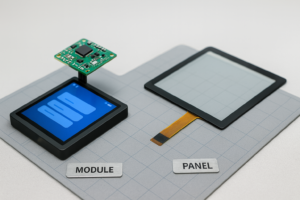In today’s digital world, touch screens have become an essential part of our everyday lives. Whether it’s on smartphones, tablets, or interactive kiosks, touch screens are everywhere. However, not all touch screens are created equal. The two most common types are capacitive and resistive touch screens, each with its own unique working principles and applications. In this article, we will explore the differences between these two types of touch screens, such as capacitive touch screens, helping you understand their functionalities and advantages.
What is a Resistive Touch Screen?
A resistive touch screen consists of two thin layers of transparent conductive material separated by a small gap. When pressure is applied to the screen, the two layers come into contact, creating an electrical circuit. This circuit sends a signal to the device’s controller, which interprets the touch location.
How it Works:
- Structure: The resistive touch screen is made up of two flexible layers, typically coated with indium tin oxide (ITO). These layers are separated by a thin air gap.
- Touch Detection: When a user presses down on the screen, the top layer touches the bottom layer, completing the circuit. The controller detects this contact and calculates the coordinates of the touch.
- Signal Processing: The controller processes the signal and sends it to the operating system, allowing the device to respond to the user’s action.
Advantages of Resistive Touch Screens:
- Cost-Effective: Resistive touch screens are generally less expensive to manufacture, making them popular for various applications.
- Durable: Their simple construction makes them robust and suitable for harsh environments.
Disadvantages of Resistive Touch Screens:
- Lower Sensitivity: Resistive screens require pressure to register a touch, making them less responsive than screens using capacitive technology.
- Limited Viewing Angles: The design of resistive screens can result in distortion when viewed from the side.
What is a Capacitive Touch Screen?
Capacitive touch screens operate on a different principle. They use the electrical properties of the human body to detect touch. A capacitive screen is coated with a transparent conductive layer that creates an electrostatic field. When a finger approaches the screen, it alters this field, allowing the device to register the touch. The technology in capacitive touch screens allows for diverse applications.
How it Works:
- Structure: Capacitive touch screens consist of a glass panel with a transparent conductive coating, usually made of ITO. Beneath the glass, there are multiple electrodes that create an electrostatic field.
- Touch Detection: When a finger touches the screen, it disrupts the electrostatic field, changing the capacitance at that point. The controller detects this change and determines the location of the touch.
- Signal Processing: Similar to resistive screens, the controller processes the touch data and communicates with the operating system to execute the desired action.
Advantages of Capacitive Touch Screens:
- High Sensitivity: Capacitive screens are highly responsive, allowing for quick and easy interactions.
- Multi-Touch Capability: Many capacitive screens support multi-touch gestures, enabling users to perform actions like pinch-to-zoom.
Disadvantages of Capacitive Touch Screens:
- Higher Cost: The manufacturing process for capacitive screens is generally more expensive.
- Environmental Limitations: Capacitive screens may not work well in wet or humid conditions, as moisture can interfere with the touch detection.
Comparing Capacitive and Resistive Touch Screens
| Feature | Resistive Touch Screen | Capacitive Touch Screen |
|---|---|---|
| Touch Method | Requires pressure | Responds to light touch |
| Sensitivity | Lower | Higher |
| Multi-Touch Support | No | Yes |
| Cost | Lower | Higher |
| Viewing Angles | Limited | Wide |
| Durability | Strong | Moderate |
| Environmental Adaptability | Good | Moderate |
Which One Should You Choose?
Choosing between a capacitive and resistive touch screen depends on your specific needs. If you’re looking for a cost-effective solution that can withstand harsh conditions, a resistive touch screen may be the right choice. However, if you require high sensitivity and multi-touch capabilities, capacitive touch screens are likely the better option.
In conclusion, understanding the differences between capacitive and resistive touch screens can help you make informed decisions when selecting the right technology for your devices. Each type has its advantages and disadvantages, making them suitable for different applications. By considering your specific requirements, you can choose capacitive touch screens or resistive ones that best meet your needs.
.png)



